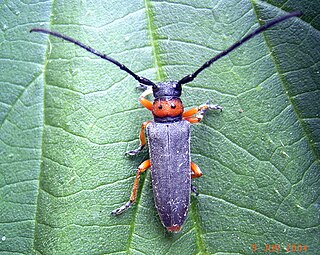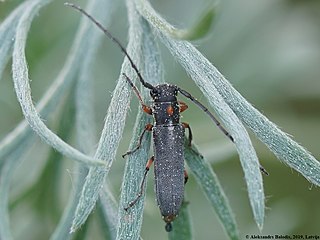Cassida sareptana is a species of brownish beetle in the leaf beetle family, found in Kazakhstan, Mongolia, Russia and Ukraine. They can be found in Near East as well. The species feeds on plants from the family Asteraceae, including tarragon and Artemisia arenaria.

Phytoecia is a genus of longhorn beetles of the subfamily Lamiinae,
Phytoecia gianassoi is a species of beetle in the family Cerambycidae. It was described by Sama in 2007 and later reclassified to the subgenus Coptosia within the genus Phytoecia.
Phytoecia paulusi is a species of beetle in the family Cerambycidae. It was described by Holzschuh in 1971.

Phytoecia puncticollis is a species of beetle in the family Cerambycidae. It was described by Faldermann in 1837. It is known from Russia, Azerbaijan, Georgia, Iraq, Armenia, Turkey, Iran, and Turkmenistan. It feeds on Eryngium billardierei.
Phytoecia gaubilii is a species of beetle in the family Cerambycidae. It was described by Mulsant in 1851. It is known from Tunisia and Algeria.

Phytoecia comes is a species of beetle in the family Cerambycidae. It was described by Henry Walter Bates in 1884. It is known from Taiwan, Myanmar, North Korea, South Korea, China, Vietnam, and Japan.
Phytoecia humeralis is a species of beetle in the family Cerambycidae. It was described by Waltl in 1838, originally under the genus Saperda. It is known from Palestine, Greece, Georgia, Iran, Azerbaijan, Syria, Cyprus, and Turkey. It feeds on Silybum marianum.
Phytoecia millefolii is a species of beetle in the family Cerambycidae. It was described by Adams in 1817, originally under the genus Saperda. It has a wide distribution between Europe and the Middle East.
Phytoecia praetextata is a species of beetle in the family Cerambycidae. It was described by Steven in 1817, originally under the genus Saperda. It is known from Turkey, Bulgaria, Syria, Armenia, Romania, and Ukraine.

Phytoecia affinis is a species of beetle in the family Cerambycidae. It was described by Harrer in 1784, originally under the genus Leptura. It has a wide distribution in Europe.
Phytoecia balcanica is a species of beetle in the family Cerambycidae. It was described by Frivaldsky in 1835, originally under the genus Saperda. It is known from Turkey, Bulgaria and Crete. It feeds on Salvia sclarea.

Phytoecia caerulescens is a species of beetle in the family Cerambycidae. It was described by Scopoli in 1763, originally under the genus Leptura. It has a wide distribution in Europe, and has been introduced into Australia. It feeds on Echium vulgare, Lappula squarrosa, Anchusa officinalis, Lithospermum officinale, and Cynoglossum officinale.

Phytoecia caerulea is a species of beetle in the family Cerambycidae. It was described by Scopoli in 1772, originally under the genus Leptura. It has a wide distribution in Europe.

Phytoecia icterica is a species of beetle in the family Cerambycidae. It was described by Schaller in 1783, originally under the genus Saperda. It has a wide distribution between Europe and the Middle East. It feeds on Daucus carota sativus, Petroselinum crispum, Pastinaca sativa sativa, Pastinaca sativa, Conium maculatum, and Pimpinella saxifraga.

Phytoecia pustulata is a species of beetle in the family Cerambycidae. It was described by Schrank in 1776, originally under the genus Cerambyx. It has a wide distribution throughout Europe and the Middle East.

Phytoecia rufiventris is a species of beetle in the family Cerambycidae. It was described by Gautier des Cottes in 1870. It is known from Russia, Japan, Taiwan, Mongolia, North Korea, South Korea, China, and Vietnam. It feeds on Artemisia vulgaris.
Phytoecia tenuilinea is a species of beetle in the family Cerambycidae. It was described by Léon Fairmaire in 1877. It is known from Morocco and Algeria.
Phytoecia hirsutula is a species of beetle in the family Cerambycidae. It was described by Frölich in 1793, originally under the genus Saperda. It has a wide distribution between Europe and the Middle East.
Zwackhiomyces sipmanii is a species of lichenicolous fungus in the family Xanthopyreniaceae. Found in the boreal ecosystem of north-eastern Russia, it was formally described as a new species in 2009 by Paul Diederich and Mikhail Zhurbenko. The type specimen was collected in the Magadan Region of Eastern Siberia at an altitude of 700 m (2,300 ft); here, on a south-exposed slope with steppe-like vegetation, the fungus was found growing on the lichen Phaeorrhiza sareptana var. sphaerocarpa. It is only known from the type locality. The species epithet honours Dutch lichenologist Harrie Sipman, "on the occasion of his 64th birthday".








